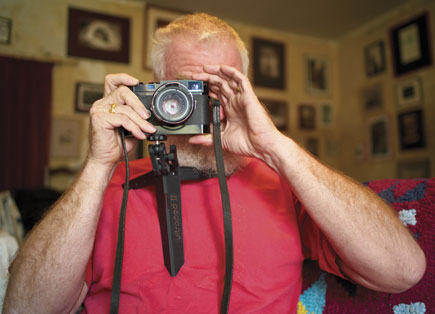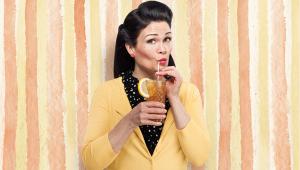6 (More) Reasons To Use A Tripod; ...And Six Reasons Not To Page 2
4. Portraiture. Many portraitists prefer not to look through the viewfinder when they press the shutter release. They find it better to be looking at the subject with both eyes, so they can judge the expression and lighting more naturally.
Of course you have to be able to trust the sitter not to move too much, lest you lose the composition or they go out of focus, but you can soon establish a feeling for this. Think of the great days of Hollywood portraiture, when they couldn’t look at the ground glass of their 8x10” cameras at the moment of exposure because the film holder was in the way: clearly, it is readily possible to work like this.
5. It stops your arms from getting tired. This may sound silly, but often, you have to wait for someone to walk into or out of a shot. I can remember standing on the Acropolis of Lindos in Rhodes and waiting halfway to forever for someone to come out of the black hole of a doorway which was the focal point of the composition.
6. It stakes out your territory. People are often less willing to push in front of you and block your view. It may be only a psychological barrier, but it can be quite a powerful one.
Why To Not Use A Tripod
Given all these advantages, why would anyone not use a tripod? Once again, there are six good arguments, though several of them can be countered to a greater or lesser extent.
1. Greater fluidity of working. There are times when a tripod simply gets in the way—literally.
2. You’re not allowed to use one. Quite a few places ban tripods, whether on the entirely fair and logical ground that they may trip people up (if there are lots of people around) or out of sheer authoritarian bloody-mindedness.
There are however two counters to this approach. One is to ask permission nicely, which surprisingly often works, though you may have to pay some sort of fee. The other is to use some other form of camera support. Rarely is it a good idea simply to ignore the prohibition and set up your tripod anyway.
3. There is nowhere steady to put it. A tripod may well result in worse pictures if you stand it on a shaking or vibrating surface, such as a boat deck (unless it’s a very big boat) or the floor of a train. You can hold the camera steadier in your hands, and it will be much better insulated against vibration.
4. Your tripod is too big and heavy. Far too many people start out with good intentions, and (usually under the influence of Internet photo forums) buy tripods that are too big and heavy to carry conveniently. They therefore leave them at home. Remember a simple truth: the lightweight tripod you have with you, and use, is a lot better than the super-solid tripod you leave at home.
5. Your tripod is too flimsy. This is the mirror image of the objection above: your tripod doesn’t hold your camera steady enough, so you don’t carry it.
6. Some other form of camera support makes more sense. Where full-sized tripods are banned, you can often get away with tabletop tripods, monopods, beanbags, and clamps.
 |
|
|
I’ll be honest. I use a tripod less than I used to, because I like a small, light, Leica outfit. Even so, I quite often carry either a SLIK Snapman or a Velbon Maxi 343i, each of which weighs just over a couple of pounds; is equipped with a ball-and-socket head; and cost several times as much as a low-end stamped-metal tripod. Alternatively, I’ll use an American-made UltraPod II tabletop tripod, which is so light (a few ounces) that it can be left dangling below the camera when you’re not using it. Such tripods can also be used for shooting through windows (put the legs against the glass and shoot between them) or as “chest pods” to stabilize the camera against your chest.
With bigger cameras I almost always use either a tripod, usually a Gitzo with a Novoflex ball-and-socket head for medium format, or (in the studio, with any format) an IFF pillar stand. And then there are my big tripods, for 5x7” and above, and the ultralight wooden MPP I use for 4x5”, and…well, put it this way, I’d rather have too many tripods than too few.
 |
|
|
For further information on the art and craft of photography from Roger Hicks and Frances Schultz, go to www.rogerandfrances.com.
Another use for tabletop tripods is as a “chest pod.” Exhale slowly; pause as you press the release; continue to exhale. Do not attempt to hold your breath!
- Log in or register to post comments

















































